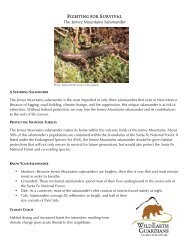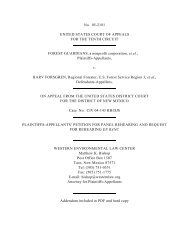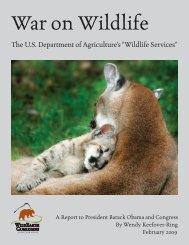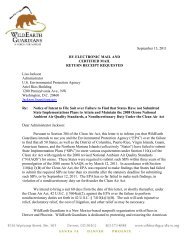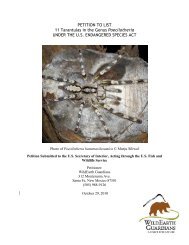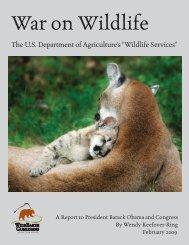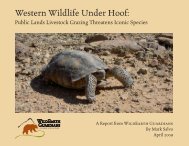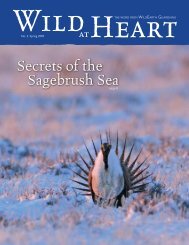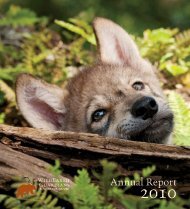Here - WildEarth Guardians
Here - WildEarth Guardians
Here - WildEarth Guardians
You also want an ePaper? Increase the reach of your titles
YUMPU automatically turns print PDFs into web optimized ePapers that Google loves.
the word from <strong>WildEarth</strong> <strong>Guardians</strong><br />
No. 9, Spring 2011<br />
New<br />
Life<br />
Working to<br />
Rewild the<br />
West
Mission Statement<br />
<strong>WildEarth</strong> <strong>Guardians</strong> protects and restores<br />
the wildlife, wild places, and wild rivers<br />
of the American West.<br />
Board of Directors<br />
Peter Schoenburg, President<br />
Robin Smith, Vice President<br />
Shannon Larsen, Treasurer<br />
Todd Ringler, Secretary<br />
Jess Alford<br />
Doug Erwin<br />
Stephanie Forrest<br />
Mark Rickman<br />
Vanessa Scurci<br />
Jon Spar<br />
Bill Syme<br />
Staff<br />
Whitney Bacon, IT Guru<br />
Bryan Bird, MS, Wild Places Program Director<br />
Rosie Brandenberger, Publications Manager<br />
Lori Colt, Communications Director<br />
Angelisa Espinoza, Office Administrator<br />
Kevin Gaither-Banchoff, Development Director<br />
Taylor Jones, Endangered Species Advocate<br />
John Horning, Executive Director<br />
Mona Kay, Bookkeeper<br />
Wendy Keefover-Ring, MA, Carnivore Protection<br />
Director<br />
Jim Matison, Restoration Projects Director<br />
Jeremy Nichols, Climate & Energy Program<br />
Director<br />
Carol Norton, Associate Director<br />
Nicole Rosmarino, PhD, Wildlife Program<br />
Director<br />
Samantha Ruscavage-Barz, Staff Attorney<br />
Mark Salvo, JD, Sagebrush Sea Campaign<br />
Director<br />
Jay Tutchton, General Counsel<br />
Ashley Wilmes, Staff Attorney<br />
Special thanks to Stephanie Pearson and<br />
Katie Arnold for copy editing<br />
<strong>WildEarth</strong> <strong>Guardians</strong> is a 501(c)(3)<br />
tax-exempt organization.<br />
Santa Fe Office:<br />
312 Montezuma Ave.<br />
Santa Fe, NM 87501<br />
Tel 505.988.9126<br />
Fax 505.989.8623<br />
Denver Office:<br />
1536 Wynkoop St.<br />
Ste. 301<br />
Denver, CO 80202<br />
Tel 303.573.4898<br />
Offices also in:<br />
Phoenix, Tucson, Boulder<br />
Cover: istockphoto.com<br />
2<br />
100 percent recycled, 50 percent PCW<br />
Restoring the Vision<br />
guardians giver<br />
rei Stores<br />
John Horning<br />
hen we lose a battle to protect wild nature, our defeat is permanent.<br />
W Once it’s lost it’s lost forever. Or is it?<br />
Clearly the extinction of a species and the clear-cutting of a 500-yearold<br />
spruce grove are acts that have irreversible consequences. But I also<br />
believe that, with a little humility and a lot of will, we can restore, rewild, and<br />
reconnect the tattered fragments of nature that still exist. We have to take these<br />
steps if endangered plants and animals are going to survive.<br />
As we’ve worked to restore streams and close old logging roads across the<br />
Southwest, we’ve done so knowing that rewilding the landscape is as much a<br />
part of our vision as is trying to prevent destruction in the first place—whether<br />
through Congress or the courts.<br />
My experience informs my belief that restoration and rewilding isn’t easy,<br />
but it can be enjoyable. Restoration is as much a social enterprise as it is an<br />
ecological one, and we’ve had lots of fun over the years while working to heal<br />
damaged lands. The bonus is that not only are we restoring our wildlands and<br />
waterways, but we’re also creating popular support and political will for a new<br />
restoration economy.<br />
As our efforts to heal damaged lands continue to gain ground, our greatest<br />
challenge will be to remind ourselves and our allies that real restoration will<br />
only come when nature’s dynamism through fires, floods, and ecosystem<br />
engineers such as wolves, prairie dogs, and beavers is restored to its rightful<br />
place on the landscape.<br />
love the west because of the wide-open spaces, the<br />
“I big blue skies, and the amazing mountains,” says<br />
Kerry Peavey, outreach specialist at nationwide outdoor<br />
retailer REI. “You can be in a different environment<br />
skiing, hiking, biking, or kayaking, all less than an hour<br />
away from Santa Fe.”<br />
Kerry and REI have been supporting <strong>WildEarth</strong><br />
<strong>Guardians</strong>’ Stream Team river restoration and treeplanting<br />
events for six years. In 2010, REI awarded<br />
<strong>WildEarth</strong> <strong>Guardians</strong> a $5,000 grant because Stream<br />
Team fits with REI’s core value of stewardship and the<br />
company’s commitment to getting people outside to care for the planet. It’s also<br />
key for REI, says Kerry, to find ways to improve the environmental performance<br />
of the business while striving to generate positive environmental, social, and<br />
financial results.<br />
REI’s passion for the outdoors runs deep, as does Kerry’s passion for our<br />
organization. “<strong>WildEarth</strong> <strong>Guardians</strong> does a great job advocating for animals. I<br />
am always learning about new endangered animals and their plight,” she says.<br />
“Without <strong>WildEarth</strong> <strong>Guardians</strong>, I probably wouldn’t know about these creatures<br />
and the important role they play.”
new and improved<br />
Lori Colt<br />
Have you seen our upgraded website? In November, we<br />
migrated our website and added a fresh new look,<br />
along with new pages and functions. We hope you find the<br />
new site easier to navigate, as well as more informative and<br />
inspiring. We’ve made our scientific petitions more<br />
accessible, highlighted our priority campaigns, and upgraded<br />
all the photographs. We’ve also unveiled a “Species We<br />
Work On” section, providing you with maps, listing<br />
petitions, fact sheets, and significant actions we have taken<br />
for your favorite plants and animals, as well as some you may<br />
never have known existed.<br />
We’ve added an “Activist Spotlight” page to highlight our<br />
members who go above and beyond. In addition, for our<br />
social media fans, we now have RSS feed, Twitter, Facebook links, Flickr photo account and are<br />
currently working to set up a blog and podcast. News buffs will enjoy our new “In the News”<br />
feature highlighting a wide variety of articles from around the country covering our work.<br />
Signing up to be a paperless Guardian has never been easier and updating your preferences and<br />
profile information is now a snap when you visit the “Learn More” button on our home page.<br />
Stay tuned for future updates and upgrades. We have lots of exciting new things in store each<br />
time you visit our site! We welcome your feedback, so feel free to email our communications<br />
director, Lori Colt, with your website improvement ideas: lcolt@wildearthguardians.org.<br />
SAve the dAtes<br />
for THESE<br />
WiLDEARTH EVENTS<br />
May 12<br />
Howling Affair, Denver<br />
june 23<br />
House Party, Tucson<br />
jUne 30<br />
Vegan BBQ, Santa Fe<br />
September 30<br />
Guardian Gala,<br />
Santa Fe<br />
November 4<br />
Tree Hugger Bash,<br />
Albuquerque<br />
Support <strong>WildEarth</strong> <strong>Guardians</strong> in raising $300,000 in new funding for our conservation work by 12/31/2011<br />
Conservation Deserves more than 2%*<br />
join us in supporting<br />
<strong>WildEarth</strong><br />
<strong>Guardians</strong><br />
*Conservation only receives<br />
2% of all charitable giving.<br />
Most people believe it<br />
deserves more. Source: Giving USA<br />
There are many ways you can support the work<br />
of <strong>WildEarth</strong> <strong>Guardians</strong>. <strong>Here</strong> are just a few.<br />
Planned Giving<br />
Make your legacy a force for nature<br />
by naming the <strong>Guardians</strong> in your will or<br />
creating an annuity.<br />
Monthly Donor<br />
Make a monthly donation via your credit<br />
card or directly from your checking account<br />
to provide consistent funding.<br />
General and Program Funds<br />
Select a specific program you would like<br />
to fund or provide the greatest amount of<br />
flexibility and give to <strong>Guardians</strong>’ annual fund.<br />
Stock Donation<br />
Stock transfer information is available on<br />
our website under “More Ways to Give.”<br />
Matching Gifts<br />
Take advantage of your employer’s<br />
matching gift program.<br />
In-Kind Gifts<br />
Give merchandise or services from your<br />
business or donate your talents.<br />
United Way<br />
Give to <strong>WildEarth</strong> <strong>Guardians</strong> as part of<br />
your United Way gift.<br />
By supporting <strong>WildEarth</strong> <strong>Guardians</strong>, a recipient of the Earth Friends Challenge, you are<br />
smartly leveraging your investment. Earth Friends Conservation Fund has challenged the<br />
<strong>Guardians</strong> to grow the percentage of donations given to the environment to more than<br />
2%. The Earth Friends Challenge recognizes groups known for their efficiency and success<br />
in accomplishing their mission. Heed this call to action by investing in <strong>WildEarth</strong> <strong>Guardians</strong>.<br />
3<br />
phOTO: Dave Renwald PhOTOgRAPhy<br />
We need your support to make our shared vision a reality. Please contact us at 505.819.5912
Why Are YOU<br />
a Guardian?<br />
When he isn’t<br />
working with<br />
untamed horses, Hal<br />
supplies thousands<br />
of trees to be planted<br />
at our Stream Team<br />
restoration site near<br />
Cuba, always with a<br />
generous spirit and<br />
bright smile.<br />
“I found out about<br />
Stream Team when<br />
I saw the crew<br />
working in an arroyo<br />
near the highway.<br />
I asked to join and<br />
have enjoyed working<br />
with the crew and the<br />
trees ever since.”<br />
— Hal Yazzie<br />
Cuba, NM<br />
Become a member of<br />
<strong>WildEarth</strong> <strong>Guardians</strong>:<br />
wildearthguardians.org<br />
leader of the pack<br />
he is the breadwinner of the family, has<br />
S two lovers, and four children. She’s gone<br />
on three-day solo hunts and has singlehandedly<br />
taken down her prey. She is ’06, the<br />
female adult of the Lamar Canyon Pack in<br />
Yellowstone. As we watch, her pups bravely<br />
charge a pair of elk, which steadily rebuff the<br />
youngsters. The pups also chase each other,<br />
playing ring-around-a-rosy near Slough Creek.<br />
Their fathers, males 754 and 755, curl up next<br />
to each other nearby. Scientists call this 755’s<br />
Group (and now the Lamar Canyon Pack),<br />
after the alpha male. But, who’s kidding who?<br />
This is the ’06 Pack.<br />
Silver Gate, Montana wolf-watcher Doug<br />
McLaughlin lives and breathes these wolves:<br />
He saw ’06 strand an adult elk in the river for<br />
three days before she took it down. He saw her<br />
mate with 754 and 755 last year and watched<br />
her pups when they first emerged from their<br />
den. He viewed the pups participating in their<br />
first kill in late March. He’s watched this family<br />
since they first became a family.<br />
Jay Tutchton, <strong>WildEarth</strong> <strong>Guardians</strong>’<br />
General Counsel, and I met Doug and the ’06<br />
Pack the day after a Missoula court hearing on<br />
whether Yellowstone’s wolves would remain<br />
protected under the Endangered Species Act<br />
(ESA). Judge Donald Molloy was considering<br />
whether to approve a settlement proposal,<br />
negotiated by ten conservation groups and the<br />
federal government, to remove the Northern<br />
Rockies wolves from the ESA list. Judge<br />
Molloy later ruled that he could not approve<br />
the settlement, as it would violate the ESA.<br />
Delistings are supposed to be based on<br />
biology, but the settlement itself would have<br />
been political delisting, as it is motivated by<br />
political fears rather than science. Representing<br />
Alliance for the Wild Rockies and Friends of<br />
the Clearwater, Jay argued that the settlement<br />
should be rejected.<br />
Nicole Rosmarino<br />
Northern Rockies wolves (except in Wyoming) will<br />
lose their ESA protections under a federal budget<br />
rider that passed in April.<br />
Even while Judge Molloy was mulling<br />
over the settlement, Sen. Jon Tester (D-MT)<br />
and other political grandstanders made it clear<br />
they could not be appeased. They kept at it in<br />
Congress and attached a wolf-delisting rider to<br />
the federal budget. As a result, ESA protections<br />
will be removed for wolves in Montana, Idaho,<br />
Utah, Oregon, and Washington.<br />
Watching the ’06 pack alongside Doug, we<br />
asked him whether they ever left the park. He<br />
said they usually stayed within it, but sometimes<br />
ventured outside. We left the cold, snowy hill<br />
from which we had been watching this family<br />
with one thought: ’06 would not go along with<br />
any actions that endanger her pack.<br />
Epilogue: We won’t give up on wolves in<br />
Yellowstone or elsewhere. We and conservation<br />
allies are set to challenge a Montana plan<br />
targeting a modest group of 30 wolves that have<br />
established themselves in a remote area of the<br />
Bitterroot National Forest. We’re contending<br />
that, even if they lose their ESA protections,<br />
government killing of wolves will violate other<br />
federal laws.<br />
Visit our website:<br />
Programs>Wildlife>Carnivore Protection<br />
doug mclaughLIN<br />
<strong>WildEarth</strong> <strong>Guardians</strong>’ General Counsel argued in court to ensure wolves continue to have the freedom to bravely<br />
charge elk in the Northern Rockies.<br />
doug mclaughLIN<br />
4
ounding up western coal<br />
t’s a roundup, all right, but in this case<br />
I we’re wrangling some of the West’s oldest<br />
and dirtiest coal-fired power plants. And<br />
in the last few months, we’ve made some<br />
electrifying progress.<br />
Our goal is to make the West coal-free<br />
by 2035. How are we doing this? By exposing<br />
the true cost of coal, and in turn exposing the<br />
fact that clean energy is both more affordable<br />
and more protective of our health and the<br />
environment.<br />
We’re successfully seizing unprecedented<br />
opportunities under the Clean Air Act to<br />
make the case. Under the law—and our<br />
vigorous enforcement of it—the nation’s oldest<br />
and dirtiest coal-fired power plants are being<br />
required to clean up. <strong>Here</strong>’s a summary of our<br />
efforts that are leading to cleanups —and even<br />
shutdowns—in several states:<br />
• Idaho: In January, the Environmental<br />
Protection Agency (EPA) proposed that one<br />
of Idaho’s coal-fired power plants slash its<br />
haze-forming pollution emissions by 80%.<br />
According to the plant owner, the proposal<br />
is likely to lead to a transition away from<br />
coal because of its cost.<br />
• New Mexico: Also in January, the EPA<br />
released a plan to force Public Service<br />
Company of New Mexico (or PNM) to<br />
retrofit all four coal-fired boilers at the San<br />
Juan Generating Station with state-of-theart<br />
pollution controls. The proposal is the<br />
strongest yet for any coal plant in the nation<br />
and would reduce haze and smog-forming<br />
pollution by more than 95%.<br />
• Oklahoma: In March, the EPA released<br />
a plan to force three of Oklahoma’s largest<br />
coal-fired power plants to slash their sulfur<br />
dioxide pollution by as much as 95%. The<br />
EPA’s proposal rejected an Oklahoma plan<br />
that would have allowed the state’s coalfired<br />
power plants to burn coal without any<br />
pollution controls.<br />
• Oregon: Also in March, EPA proposed<br />
to approve a plan that would commit<br />
Oregon’s only coal-fired power plant to<br />
retiring by 2020. The plan is a milestone<br />
as it represents the first time the EPA<br />
has proposed to approve a retirement<br />
plan to meet federally required pollution<br />
reductions.<br />
Jeremy Nichols<br />
From ripping up Western landscapes to extract coal to the<br />
deadly air pollution its use leaves behind, coal is never clean.<br />
<strong>WildEarth</strong> <strong>Guardians</strong> is working toward a coal-free<br />
West by 2035.<br />
All of this was spurred, in large part, by a<br />
2009 lawsuit filed by <strong>WildEarth</strong> <strong>Guardians</strong>,<br />
which committed the EPA to take these<br />
actions. And even more progress is on the<br />
horizon: Because of our ongoing legal efforts,<br />
the EPA is also on track to require clean ups<br />
at coal plants in Colorado, Montana, North<br />
Dakota, and Utah.<br />
Our aim is simple: to use these retrofit<br />
proposals as springboards for coal plant<br />
retirement or re-powering. Instead of spending<br />
millions to make coal clean, let’s invest in<br />
something that’s clean to begin with, like wind,<br />
solar, and greater efficiency and conservation.<br />
With coal-fired power plants throughout the<br />
West facing millions of dollars in upgrades, the<br />
time is ripe for clean energy to come out ahead.<br />
Visit our website: Programs>Climate and Energy<br />
BLM/Wyoming<br />
istockphOTO.com<br />
Why Are YOU<br />
a Guardian?<br />
With a degree in<br />
Parks & Recreation<br />
Management from<br />
Northern Arizona<br />
University and a<br />
passion for the<br />
outdoors, Billy<br />
Meyers was already<br />
connected to the idea<br />
of rewilding. But he<br />
was eager to volunteer<br />
to plant trees when<br />
he first heard about<br />
<strong>WildEarth</strong> <strong>Guardians</strong>’<br />
restoration work.<br />
“I enjoy working in<br />
beautiful places and<br />
do this for the learning<br />
experience.”<br />
— Billy Meyers<br />
Santa Fe, NM<br />
Become a member of<br />
<strong>WildEarth</strong> <strong>Guardians</strong>:<br />
wildearthguardians.org<br />
5
Why Are YOU<br />
a Guardian?<br />
In the Halls of Justice<br />
Samantha Ruscavage-Barz and Ashley Wilmes<br />
<strong>WildEarth</strong> <strong>Guardians</strong>’ team of staff attorneys and outside legal counsel have been hard at<br />
work to make sure the cries of the West’s wildlands and wildlife are heard in courtrooms<br />
before it’s too late. The following cases are a few highlights.<br />
Steve loves the<br />
outdoors and<br />
has a degree in<br />
Environmental Studies<br />
with an emphasis in<br />
water, so he found our<br />
river restoration work to<br />
be a great personal fit.<br />
His job with <strong>WildEarth</strong><br />
<strong>Guardians</strong>: Selecting<br />
just the right spot to<br />
plant the trees and<br />
working with the team<br />
to position them deep<br />
enough to reach the<br />
water table so they can<br />
successfully take root.<br />
“I want to learn, meet<br />
new people, and help<br />
protect the resources<br />
and the beautiful<br />
landscapes of New<br />
Mexico.”<br />
6<br />
— Steve Bogott<br />
Gunnison, CO<br />
Become a member of<br />
<strong>WildEarth</strong> <strong>Guardians</strong>:<br />
wildearthguardians.org<br />
Clean Air<br />
<strong>WildEarth</strong> <strong>Guardians</strong> v. Lamar Utilities<br />
Board and Arkansas River Power Authority<br />
On March 23, 2011, <strong>Guardians</strong> filed suit<br />
against Lamar Light and Power over thousands<br />
of violations of the Clean Air Act at the<br />
Lamar coal-fired power plant in eastern<br />
Colorado. Since converting from natural gas<br />
to coal in May 2009, the Lamar Plant has been<br />
dumping illegal amounts of pollution into the<br />
air, including nitrogen oxides, sulfur dioxide,<br />
carbon monoxide, and particulate matter. These<br />
toxic pollutants spew from a large smokestack<br />
phOTO courtesy of RAY<br />
RAFITI PhOTOgRAPhy<br />
in the middle of the town of Lamar, posing<br />
serious threats to the health of local residents<br />
and the surrounding environment. With the<br />
aid of the University of Denver Environmental<br />
Law Clinic, <strong>Guardians</strong> has also been litigating a<br />
case against the coal plant over its failure to use<br />
the Maximum Achievable Control Technology<br />
to reduce emissions of mercury and other<br />
hazardous air pollutants.<br />
Clean lAnd<br />
<strong>WildEarth</strong> <strong>Guardians</strong> et al. v. Salazar et al.<br />
In 2009, <strong>Guardians</strong> petitioned the Secretary<br />
of Interior, Ken Salazar, and Bureau of Land<br />
Management to have BLM change its process for<br />
selling access to the nation’s most productive coal<br />
deposits. The Powder River Basin in Wyoming<br />
and Montana provides upwards of 42 percent of<br />
the nation’s coal. Under BLM’s current leasing<br />
policy, the coal companies drive the leasing<br />
process by deciding the number and size of<br />
coal leases, and BLM limits its environmental<br />
analyses to impacts from individual leases.<br />
<strong>Guardians</strong>’ Petition asked Secretary Salazar and<br />
BLM to recertify the Powder River Basin as a<br />
Coal Production Region, which would require<br />
BLM to drive the leasing process, set regional<br />
leasing levels, and perform environmental<br />
analyses of impacts to the Powder River Basin<br />
as a whole, as well as consider climate change<br />
impacts from burning Powder River Basin coal.<br />
On January 28, 2011, BLM denied <strong>Guardians</strong>’<br />
Petition, a denial that flies in the face of all<br />
reason given that the Powder River Basin is the<br />
single largest coal producer in the nation, and<br />
among the largest coal producers in the world.<br />
On March 30, 2011, <strong>Guardians</strong> filed a lawsuit<br />
in federal court challenging BLM’s denial of<br />
<strong>Guardians</strong>’ Petition.<br />
Clean Water<br />
Petition to Nominate Surface Waters in<br />
Forest Service Wilderness as ONRWs<br />
On November 30, 2010, the New Mexico<br />
Water Quality Control Commission<br />
designated perennial waters in U.S. Forest<br />
Service Wilderness Areas in New Mexico<br />
as Outstanding National Resource Waters.<br />
ONRWs are intended to prevent further<br />
degradation of water quality and, in so<br />
doing, create an opportunity for water<br />
quality restoration. The New Mexico Cattle<br />
Growers Association, a trade group opposed<br />
to strengthening water quality protections for<br />
some of New Mexico’s most pristine waters,<br />
challenged ONRW designation in the New<br />
Mexico Court of Appeals. <strong>Guardians</strong> has<br />
moved to intervene on the side of the Water<br />
Quality Control Commission to defend<br />
ONRW designation and keep these important<br />
water quality protections in place for New<br />
Mexico’s most fragile resource.<br />
Visit our website: Take Action<br />
ecoflight<br />
phOTO courtesy of RAY<br />
RAFITI PhOTOgRAPhy
campaign updates<br />
wildearth gUARDIANS<br />
dave jones<br />
Telluride Prairie Dogs<br />
On January 11, 2011, <strong>WildEarth</strong><br />
<strong>Guardians</strong> presented a slideshow to the<br />
Telluride Town Council on the need to<br />
protect Gunnison’s prairie dogs, one of five<br />
species of prairie dogs that exist, all of which<br />
are imperiled. Citizens showed up in force<br />
and many spoke eloquently of their personal<br />
connection to these animals. The town<br />
councillors unanimously agreed that lethal<br />
control be taken off the table when it comes<br />
to the valley floor prairie dogs. <strong>Guardians</strong><br />
is now working with the community on a<br />
prairie dog management plan.<br />
Visit our website:<br />
Top Priorities>Protecting the Prairie Dog Empire<br />
Clean Waters, Wild Forests<br />
Now that we have made significant progress in<br />
protecting headwater streams and rivers in New Mexico,<br />
<strong>WildEarth</strong> <strong>Guardians</strong> is bringing this distinctive<br />
campaign to Colorado, where over 6,000 miles are<br />
suitable. Since the beginning of the year, we’ve met with<br />
conservation allies and municipal leaders in Colorado<br />
and traveled to the nation’s capital to brief officials in the<br />
Obama Administration. So far, the reception to Clean<br />
Waters, Wild Forests for Colorado is overwhelmingly<br />
positive. Look for action opportunities to educate<br />
Colorado’s political leaders on waters in National Forest<br />
roadless areas in that state.<br />
Visit our website: Top Priorities>Clean Waters, Wild Forests<br />
Challenging Bobcat Trapping<br />
<strong>WildEarth</strong> <strong>Guardians</strong> continues our work<br />
against trapping by extending our campaign<br />
to bobcats. Bobcats have tufted, black ears and<br />
short, six-inch tails. Their name is a shortened<br />
version of “bob-tailed cat.” Their scientific name,<br />
Lynx rufus, refers to their beautiful reddishbrown,<br />
spotted coats, prized by fur buyers.<br />
U.S. bobcats enjoy no federal protections and<br />
few state protections. New Mexico supplied a<br />
jaw-dropping 22,961 bobcat furs to the world’s<br />
fur market during the years 2000 to 2010, while<br />
Colorado contributed 11,044. <strong>WildEarth</strong><br />
<strong>Guardians</strong> works in both states to stop bobcat<br />
trapping and the trapping of other species.<br />
Visit our website: Top Priorities>Trapping<br />
jess alford<br />
Why Are YOU<br />
a Guardian?<br />
Bill, a maintenance<br />
technician for Sunwest<br />
Silver, joined the<br />
volunteer restoration<br />
crew after reading a<br />
2003 Albuquerque<br />
Journal article about<br />
our Rio Puerco<br />
planting.<br />
“When I was eight,<br />
I visited my great<br />
grandfather, Leo<br />
Sandoval, in Cuba.<br />
He told me that when<br />
he was my age he<br />
used to catch trout in<br />
the Rio Puerco right in<br />
town. I couldn’t<br />
believe it. So when<br />
I heard about tree<br />
planting on the river,<br />
I decided I’d try to<br />
bring the stream<br />
back to the way it<br />
had been for my<br />
grandfather.”<br />
—Bill Rose<br />
Albuquerque, NM<br />
Become a member of<br />
<strong>WildEarth</strong> <strong>Guardians</strong>:<br />
wildearthguardians.org<br />
7
new life<br />
Working to Rewild the West<br />
John Horning<br />
Mud Caked and<br />
Sweat Soaked<br />
Each year, from<br />
January through May,<br />
<strong>WildEarth</strong> <strong>Guardians</strong>’<br />
dedicated restoration<br />
crew spends long,<br />
hard days preparing<br />
sites for our volunteer<br />
tree-planting events.<br />
Wildearth gUARDIANS<br />
Before: June 2005 After: September 2010<br />
After winning the first-ever New Mexico grazing lease for conservation on the Rio Puerco in 1997, <strong>WildEarth</strong><br />
<strong>Guardians</strong> began the painstaking task of planting thousands of native trees to rewild the area in central New<br />
Mexico. Inspired? See more about our restoration projects at wildearthguardians.org.<br />
8<br />
These crew members<br />
expose themselves<br />
to harsh and varied<br />
weather conditions,<br />
often living on site<br />
for several weeks at<br />
a time. They usually<br />
finish the day coated<br />
in mud, dirt, and<br />
sweat from their<br />
efforts to prepare,<br />
plant, and protect<br />
native riparian<br />
vegetation.<br />
A salute to our<br />
hard-working<br />
advance team.<br />
Without them,<br />
we couldn’t<br />
plant 100,000<br />
trees each year.<br />
wildearth gUARDIANS<br />
It was a cold, crisp blue spring morning<br />
in 1997 when a hardy group of 25 souls<br />
ventured out to the muddy, barren, and, in<br />
some places, still snow-covered banks of the<br />
Rio Puerco in northwestern New Mexico. We<br />
had gathered with one goal in mind: to bring<br />
this degraded river back to life by planting<br />
native cottonwoods and willows.<br />
Though the river pulsed with possibility<br />
brought on by the early snowmelt from the<br />
flanks of the giant caldera that forms the<br />
heart of the Jemez Mountains, its ecological<br />
condition did little to inspire optimism—even<br />
for those of us who were energized by the<br />
challenge.<br />
A rapid ecological assessment we<br />
conducted the previous fall revealed that the<br />
once-lush cottonwood-and-willow forest had<br />
been nearly eliminated. Remnants of heavily<br />
Restoration Director Jim Matison (center) has<br />
spearheaded the ecological rebirth of dozens of streams.<br />
grazed willow thickets in hard-to-reach places<br />
provided hints of the river’s ecological past.<br />
But the stream was shallow and wide instead<br />
of narrow and deep, and was choked with<br />
sediment that bled into the water from its<br />
trampled and unstable banks.<br />
The culprit in this ecological disaster: two<br />
centuries of year-round cattle grazing. Dozens<br />
of plants and animals that had once used this<br />
riverbank for nesting, feeding, and rearing<br />
their young had been forced out. As a result of<br />
the ecological collapse, this entire ecosystem<br />
was now endangered.<br />
But we were not there to assign blame.<br />
We were there to begin the healing process.<br />
Earlier that fall <strong>WildEarth</strong> <strong>Guardians</strong><br />
had won the privilege of restoring the Rio<br />
Puerco by outbidding a rancher and securing<br />
the first-ever grazing lease for conservation<br />
purposes. But in winning the lease and<br />
solving one problem—removing the cows—we<br />
had created another. How would we restore<br />
the land?<br />
I had no direct experience to draw on<br />
and <strong>WildEarth</strong> <strong>Guardians</strong>, up to that point,<br />
had only been a bare-knuckled advocate for<br />
changes in how public lands are managed. We<br />
knew what was wrong and who we thought<br />
was responsible, but we didn’t know how to<br />
make it right.<br />
Somehow we persevered through the<br />
uncertainty. On that cold spring morning we<br />
had assembled enough knowledge and warm<br />
bodies to begin to restore the Rio Puerco.<br />
By the end of the first day, with the<br />
river’s mud caking our shoes and pants, we<br />
had planted more than 100 cottonwoods and
nearly 2,000 willows. We left exhausted, but<br />
exhilarated that we had taken real steps to heal<br />
a wounded landscape.<br />
Bigger and Better<br />
Since those early days when we relied almost<br />
exclusively on borrowed equipment and<br />
volunteer labor, <strong>WildEarth</strong> <strong>Guardians</strong>’<br />
restoration operation has been transformed<br />
under the leadership of our restoration<br />
program director, Jim Matison.<br />
Not only does Jim now have nearly a<br />
dozen full- and part-time staff members<br />
and a budget of more than $600,000, he and<br />
<strong>WildEarth</strong> <strong>Guardians</strong> have also significantly<br />
expanded the number of sites where we work.<br />
In addition to New Mexico and Arizona,<br />
we’re also working to expand into Colorado.<br />
We’ve also gone from working exclusively<br />
on lands we control to partnering with the<br />
U.S. Forest Service, the Bureau of Land<br />
Management (BLM), and many private<br />
landowners. And over the last 15 years we’ve<br />
planted hundreds of thousands of cottonwoods,<br />
willows, and other native shrubs and trees.<br />
Our work has expanded, but our<br />
vision has remained the same, which is that<br />
grassroots restoration and rewilding efforts are<br />
a critical aspect of <strong>WildEarth</strong> <strong>Guardians</strong>’<br />
brand of environmental advocacy. Getting<br />
our feet wet and our hands dirty to jumpstart<br />
restoration is just as important as winning<br />
lawsuits.<br />
We also still believe that restoration<br />
isn’t just an ecological enterprise; it’s a social<br />
one as well. That means we need to involve<br />
communities and inspire citizens in addition<br />
to ensuring a high rate of success for our<br />
cottonwood and willow plantings.<br />
Building with Beavers<br />
As I returned year after to year to watch<br />
the Rio Puerco transform into a narrow<br />
stream with a native cottonwood-willow<br />
bosque shading its banks, a highlight was<br />
Cottonwoods chiseled by beaver signify the return of<br />
healthy, functioning ecosystems on our river restoration<br />
sites.<br />
finding that one of our largest cottonwoods<br />
had been cut down by a pioneering beaver.<br />
Instead of greeting that chiseling castor<br />
with disappointment, I was excited because<br />
its presence signaled a whole new cycle of<br />
restoration.<br />
Beavers don’t plant trees, but they are<br />
ecosystem engineers. Their dams create<br />
ponds and wetlands. As they move up- and<br />
downstream their dams can recharge an entire<br />
floodplain, transforming it into one huge, wet<br />
sponge.<br />
Their work had already begun to<br />
transform the Santa Fe River, which had<br />
also been the beneficiary of a multi-year<br />
<strong>WildEarth</strong> <strong>Guardians</strong> restoration campaign.<br />
Thanks to a few wet years and the work<br />
of the beavers the river corridor had been<br />
transformed. We may have lost cottonwoods<br />
and willows by the hundreds to the beavers’<br />
hearty appetite, but new cottonwood and<br />
willow saplings grew by the thousands.<br />
The beavers’ hard work on the Santa Fe<br />
River made us realize that we needed to use<br />
their skills on a much larger scale: climate<br />
change and increased drought and loss of<br />
water was adding urgency to our efforts.<br />
Economic<br />
Stimulus<br />
Restoration of<br />
natural ecosystems<br />
can be a boon for<br />
the economy and<br />
the environment.<br />
Forest Service<br />
economists estimate<br />
that for every $1<br />
million spent on<br />
forest watershed<br />
restoration, 13 to 17<br />
jobs are created.<br />
<strong>WildEarth</strong> <strong>Guardians</strong><br />
created 22 jobs and<br />
spent more than five<br />
years closing and<br />
obliterating more<br />
than 32 miles of<br />
roads that damage<br />
watersheds and<br />
wildlife habitat<br />
in the Santa Fe<br />
National Forest,<br />
creating a win-win<br />
situation for<br />
everybody.<br />
Before: September 2006 After: September 2010<br />
After planting native cottonwood and willow trees, the change at <strong>WildEarth</strong> <strong>Guardians</strong>’ restoration site in central<br />
New Mexico is dramatic.<br />
9
gift of life<br />
If you’ve ever hugged<br />
a tree, sat in the shade,<br />
or reached for a branch<br />
to climb, you already<br />
know that trees can<br />
heal and bring joy.<br />
Two years ago, Win<br />
Allen and Elizabeth<br />
Hightower asked<br />
friends to donate trees<br />
to <strong>WildEarth</strong> <strong>Guardians</strong><br />
in lieu of traditional<br />
wedding gifts. Today<br />
they have a grove in<br />
their honor.<br />
To start your own grove,<br />
we will put any amount<br />
of trees ($10 per tree)<br />
in your name or the<br />
name of a loved one<br />
and send a beautiful<br />
card commemorating<br />
your generous gift.<br />
Not only that, but<br />
<strong>WildEarth</strong> <strong>Guardians</strong>’<br />
donor Chris Otahal will<br />
match, two to one, all<br />
donations given for this<br />
year’s tree plantings,<br />
up to $20,000.<br />
Visit “Plant a Tree”<br />
under “Support Us” at<br />
wildearthguardians.org.<br />
10<br />
Recovering beavers, which had<br />
been extirpated from thousands of<br />
streams due to trapping and habitat<br />
degradation, seemed like an elegantly<br />
simple and wildly ambitious approach<br />
to restoration.<br />
And so, in 2007, we started<br />
our beaver restoration and climate<br />
adaptation project. The goal: To<br />
restore beavers to the headwaters<br />
of as many Southwestern streams as<br />
possible. For the last few years we’ve<br />
been working with the U.S. Forest<br />
Service to identify potential, suitable,<br />
and occupied habitats to overcome<br />
obstacles to beaver reintroduction.<br />
Road Restoration<br />
As we restored more and more miles of<br />
river we came to realize that healthy stream<br />
corridors, though biologically critical, weren’t<br />
enough to reconnect and rewild whole<br />
ecosystems. Important wildlife corridors<br />
also exist in the forested highlands of the<br />
West, many of which have also been severely<br />
tattered by logging, road building, and fire<br />
suppression.<br />
On the northern edge of the same caldera<br />
that spawns the headwaters of the Rio Puerco,<br />
a system of old, abandoned logging roads<br />
had fragmented forest ecosystems, altered<br />
hydrology, and disrupted wildlife dispersal<br />
patterns.<br />
Thankfully the Santa Fe National<br />
Forest had also recognized the problem and<br />
completed an environmental analysis that made<br />
it easier to begin decommissioning and closing<br />
old roads to slowly reconnect small, isolated<br />
patches of forest into one bigger whole.<br />
Five years ago we secured a pioneering<br />
$360,000 grant from the federal Collaborative<br />
Forest Restoration Program that brought<br />
together a diverse partnership between the<br />
Gallina Middle School, local contractors,<br />
the Forest Service, and the New Mexico<br />
Game and Fish Department. Our challenge<br />
was to close and decommission unnecessary<br />
roads, which would help bring the area one<br />
step closer to complying with the Santa Fe<br />
National Forest’s land use standards.<br />
Firewood cutters cut some trees while<br />
another company helped re-contour the<br />
landscape to remove the roads’ imprint.<br />
The Gallina Middle School did much of the<br />
monitoring to assess changes and evaluate<br />
the project’s effectiveness. Having the<br />
local community participate in and benefit<br />
economically from the work was critical.<br />
By the time we completed the project<br />
last fall, we had removed more than 30 miles<br />
Connecting people to local rivers and streams and building<br />
relationships as volunteers return to plant trees year after year is<br />
inspiring and rewarding.<br />
of old roads, double what we had originally<br />
set out to do.<br />
One of its greatest successes wasn’t just<br />
the roads we closed and the wilder landscape<br />
we left in its place. We also began to shift the<br />
public discourse about restoration from its<br />
narrow and misguided focus on “thinning”<br />
fire-prone forests to the much more important<br />
challenge of closing the tens of thousands of<br />
miles of old logging roads that pockmark our<br />
public lands all across the West.<br />
And there is much more work that<br />
needs to be done. There are more than<br />
386,000 miles of roads on the national<br />
forests throughout the country that could<br />
be decommissioned and closed. Restoring<br />
these roads would heal damaged watersheds,<br />
reconnect fragmented wildlands, and reduce<br />
taxpayer expense for road maintenance. We<br />
can’t do it all, but we are off to a great start.<br />
Real Connections<br />
As we’ve completed these restoration projects,<br />
we’ve come to realize that our progress can’t<br />
only be measured by the work we’ve done.<br />
Rather, the greatest satisfaction comes in the<br />
relationships we’ve built with people and<br />
places—people who return year after year to<br />
dig, plant, pull, sweat and connect with those<br />
engaging in the same restorative acts; and places<br />
that contribute to our need for awe and beauty.<br />
For us, one of the greatest pleasures of<br />
rewilding is not only the doing, but also the<br />
watching. We’ve watched the Rio Puerco<br />
transform from a bare, naked skeleton of itself<br />
into a full and complete river corridor. We<br />
feel tremendous pride and hope from our<br />
work on the Rio Puerco—and the many other<br />
places that we’ve restored—and those wells of<br />
emotion continue to fuel our advocacy work<br />
today and will do so into the future.<br />
Visit our website: Programs>Wild Rivers<br />
JESS alford
Good news from the guardians<br />
rich reading<br />
Big Win<br />
Late in 2010, <strong>WildEarth</strong><br />
<strong>Guardians</strong> participated in<br />
weeks of technical hearings on<br />
Outstanding Waters in New<br />
Mexico. Despite strong opposition<br />
from the public lands cattle<br />
industry, including an 11th hour<br />
court battle, we won! In addition<br />
to presenting five technical<br />
experts, including a green<br />
economist and a fisheries biologist,<br />
<strong>WildEarth</strong> <strong>Guardians</strong> generated<br />
public comment overwhelmingly<br />
in favor of Clean Water, Wild<br />
Forests. The Water Commission voted to protect the state’s cleanest waters in Forest Service<br />
Wilderness Areas on November 30. Unfortunately, this victory will have to be defended, as the<br />
cattle industry is mounting a court challenge.<br />
Visit our website: Top Priorities>Clean Waters, Wild Forests<br />
Annual Prairie Dog Day Inspires<br />
<strong>WildEarth</strong> <strong>Guardians</strong> celebrated Prairie Dog<br />
Day by releasing our fourth annual “Report from<br />
the Burrow: Forecast of the Prairie Dog,” grading<br />
state and federal agencies on prairie dog conservation.<br />
The report was distributed to state agencies,<br />
prairie dog activists, the media, and selected<br />
senators, representatives, and governors. At the<br />
Denver Zoo, we helped kids discover what animal<br />
they would be if they lived in a prairie dog town.<br />
And along with the Prairie Dog Coalition of The<br />
Humane Society of the United States, we took students<br />
from Lowry Elementary School to the Plains<br />
Conservation Center to meet wild prairie dogs and<br />
explore the amazing diversity of grassland wildlife.<br />
Visit our website:<br />
Top Priorities>Protecting the Prairie Dog Empire<br />
wildearth gUARDIANS<br />
Donate with<br />
Confidence!<br />
This good news is<br />
made possible by<br />
your generous<br />
donations. As<br />
evidenced by our<br />
consistent 4-star<br />
rating from Charity<br />
Navigator, <strong>WildEarth</strong><br />
<strong>Guardians</strong> efficiently<br />
and effectively<br />
leverages your<br />
donations to get the<br />
job done.<br />
Help keep<br />
the good news<br />
flowing by making<br />
a gift to <strong>WildEarth</strong><br />
<strong>Guardians</strong> today.<br />
505.988.9126 x0<br />
or donate at<br />
wildearthguardians.org.<br />
Stream Team 2011<br />
In 2011, <strong>WildEarth</strong> <strong>Guardians</strong> and our many<br />
hard working volunteers planted thousands of<br />
trees to restore critical habitat in Ojo Caliente<br />
and Valles Caldera National Preserve, two<br />
important and beautiful places that have been<br />
wounded by years of degradation. Over the<br />
course of 20 days, volunteers such as Norbert<br />
Sperlich, Mona Kay, and Dennis Letters placed<br />
20-foot cottonwood poles and bundles of<br />
willows into holes up to eight feet deep. They<br />
worked hard and got dirty, and as a result, San<br />
Antonio Creek and three other streams like it<br />
will someday host trout and willow flycatcher<br />
and even beavers. We love planting trees!<br />
Visit our website: Programs>Wild Rivers>Stream Team<br />
wildearth gUARDIANS<br />
11
Non-Profit Org.<br />
U.S. Postage<br />
PAID<br />
Albuquerque, NM<br />
Permit #476<br />
312 Montezuma Avenue<br />
Santa Fe, NM 87501<br />
Guardian profiles<br />
Ashley Wilmes<br />
Ashley Wilmes is a<br />
staff attorney for<br />
<strong>WildEarth</strong> <strong>Guardians</strong>,<br />
where she focuses on<br />
fighting polluters and<br />
holding our federal agencies<br />
accountable for protecting<br />
wildlife and wild places of<br />
the West. Ashley comes to<br />
<strong>WildEarth</strong> <strong>Guardians</strong><br />
after working as a project<br />
attorney at the University of<br />
Denver’s Environmental<br />
Law Clinic and as a public<br />
interest attorney. She received her Juris Doctorate from the<br />
University of Oregon School of Law in 2002, with a specialty<br />
certificate in Environmental and Natural Resources Law.<br />
During law school, Ashley helped organize the Public Interest<br />
Environmental Law Conference and was a student attorney at<br />
the Western Environmental Law Center. She earned her<br />
bachelor’s degree from Centre College in Danville, Kentucky,<br />
and spent semesters in London and the Central African<br />
Republic. Ashley lives in Boulder, Colorado, with her<br />
husband, Tom, and their son, Thomas.<br />
Taylor Jones<br />
T<br />
aylor Jones joined<br />
<strong>WildEarth</strong><br />
<strong>Guardians</strong> in 2010 as our<br />
Endangered Species<br />
Advocate. She received<br />
an M. Sc. in Conservation<br />
Biology and Sustainable<br />
Development from the<br />
University of Wisconsin–<br />
Madison in 2010, where<br />
she was a member of the<br />
Carnivore Coexistence<br />
Lab. Before entering<br />
graduate school, she did a<br />
variety of conservation<br />
work in New Mexico<br />
and Colorado, including prairie dog relocation and riparian<br />
area surveys. She has been fascinated by animals and plants<br />
both great and small throughout her whole life, from<br />
watching ants as a child to completing a Master’s thesis on<br />
the Andean bear. She intends to apply one of the<br />
Bodhisattva vows to her work with endangered species:<br />
“Beings are numberless; I vow to save them all.”



